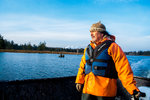
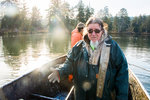
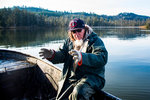
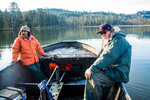
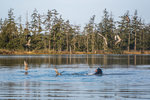
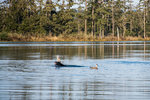
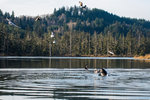
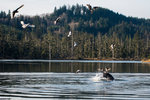
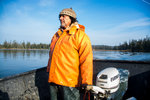
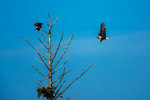
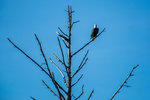



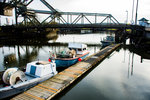
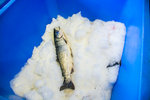
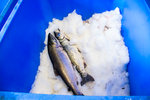
There’s a November chill in the air as Ed Johnstone checks his fishing nets, one bend of the Chehalis River upstream of Cosmopolis. He hauls the nets over the bow of his weathered boat and pulls, hand over hand, to inspect their contents. He finds eggs, pieces of salmon flesh — but no fish.
Nearby, a half-dozen or so sea lions surface intermittently, the reason so many of the salmon that find their way into Johnstone’s nets are gone before he can retrieve them.
“It’s combat fishing,” he says.
As gulls circle and fill the air with their cries, Johnstone talks about his history on this river. A member of the Quinault Indian Nation, he’s been fishing the Chehalis since the 1974 legal decision that restored treaty-guaranteed fishing rights to Native American tribes, including fishing on off-reservation waters. Though the Quinault reservation is well north of the Chehalis River on the Olympic Peninsula, tribal members have been fishing its waters for thousands of years, and many have found their way back to the river in the four-plus decades since the Boldt Decision was rendered.
“In the fall time, September, October, November, December, January, February, sometimes into March and April, this is where we’re at,” said Johnstone, who serves as the tribe’s fisheries policy spokesperson. “To me it has a real special meaning because I’ve got nephews that were teenagers when they started fishing with me.”
Suddenly, there’s a thrashing in the net not far away, and Johnstone maneuvers the boat to collect the salmon he’s caught. Before he gets there, though, a sea lion surfaces downstream with the fish in its mouth, and a flock of gulls swoops in looking for wayward scraps. Johnstone will be going back to the boat launch empty-handed.
Today, though, Johnstone’s concern isn’t with the sea lions raiding his nets. He’s worried about a proposed dam 100 or so river miles away near Pe Ell, that’s currently undergoing the environmental analysis that could decide whether it gets built.
Johnstone has seen his fishery affected by many things he can’t control — sea lions, rain patterns, hypoxia and ocean acidification on Pacific waters that kills many salmon before they even make it back to the river. To put in a man-made dam that could potentially exacerbate the habitat decimation that is already straining the environment seems like a dubious proposition to him.
“We have to be more conservative because of these uncertain conditions,” he says. “Extinction is not an option. We have to do what we can to retain those populations.”
The proposed dam, of course, is the structure local leaders in Lewis County hope will mitigate flooding that has devastated places like Centralia and Chehalis. The project has been discussed for years, following the 2007 flood that caused nearly $1 billion of economic damage and closed I-5 for days.
The plan, as currently drafted, would put the structure on the Chehalis River near Pe Ell, leaving the gates open under most conditions to let the river flow as normal. Only under severe flooding events — every decade or so — would the gates be closed to create a temporary reservoir and limit damaging surges downstream. When gates are raised during flooding, a trap-and-haul facility will bring salmon upstream.
Earlier this fall, the Washington State Department of Ecology and the U.S. Army Corps of Engineers began an environmental review process to study the potential effects of the dam. The first draft environmental impact statement is expected to be produced in early 2020.
Much of the attention locally has been focused on the flooding issue, and the Chehalis Basin Board is stocked with familiar names who have long been locally involved in that area. Lewis County commissioner Edna Fund is one of the dam project’s backers as a supervisor of the Chehalis Basin Flood Control Zone District that is sponsoring the proposal. Vickie Raines, a Grays Harbor County commissioner, has long worked on the flooding issue in her position on the Chehalis River Basin Flood Authority. J. Vander Stoep, a Chehalis lawyer and former state representative, is one of the area’s leading flood authorities. Chehalis Tribe chairman Harry Pickernell, a leader familiar to those in and around Lewis County, also serves on the board.
But the board also includes a Quinault representative, vice president Tyson Johnston. With so much of the attention being paid to flooding on the upper Chehalis, Johnston and the Quinault Tribe are hoping to shed more light on the dam’s basin-wide effects — including their fishing grounds on the lower Chehalis.
“We haven’t had the opportunity as a tribe to talk about what our perspective is in the process and the different points of entry that we’ve had,” Johnston said. “The Nation’s here as the only tribal group that has these adjudicated treaty rights to resources that we have fought to regenerate, to have our practices come back. To see that threatened in any way is something we’re going to be concerned about.”
The tribe has had to fight hard to establish its fisheries on the Chehalis. Until the Boldt decision in 1974, Quinault fishermen were restricted to fishing only on their reservation on the Olympic Peninsula. The ruling restored Native tribes’ right to half of the harvestable salmon on their historic fishing grounds and made them co-managers with the state of those fisheries. Quinault leaders say their tribe’s ability to demonstrate their own established conservation management practices helped push the decision in the Indians’ favor. Even after that legal victory, those gains weren’t easy to come by.
“I couldn’t find anyone brave enough to come out here,” said Francis Rosander, a longtime fisherman who tried to reestablish Quinault fishing on the Chehalis River soon after the tribe’s rights were restored. “We were threatened that if we came out here, we’d get shot. So I came out here and got shot at. We found out they weren’t kidding about that.”
Rosander has held myriad roles with the tribe, including serving on the Tribal Council and as an associate judge of the Tribal Court, but he’s always been a fisherman. Despite the anger and violence of some who saw the tribe’s presence as an encroachment, he and other pioneers began to reestablish the Chehalis River as an important component of the Quinault Tribe’s fishery profile. Today, the Chehalis is the most important economic waterway for Quinault fishermen.
“It’s well over half of what we capture on an annual basis for our revenue,” said David Martin, the tribe’s chief strategy officer of business development. Martin has also served as vice president of the tribe and general manager of its Land and Timber Enterprise.
Last year, two Quinault Tribe enterprises, Jolly Roger Seafood and Quinault Pride Seafood, brought in more than $19 million in revenue and employed 77 people, according to Andrea Halstead, the tribe’s chief operating officer. Those businesses represent just a portion of the ways in which Quinault salmon fishing contributes to the economy. According to a 2015 study, the tribe generated 668 direct jobs through treaty fishery activities and Quinault-owned businesses — a total of nearly $28 million in wages. Another 107 indirect jobs were supported by the $32 million in purchases supplying those services.
Halstead grew up fishing the Chehalis with her father, and watched as the family’s fortune’s ebbed and flowed with the salmon runs.
“We lived a childhood of feast of famine,” she said. “In the fall, we always had plenty to go around. Summertime, that’s when we were drinking powdered milk. As a child at the time, I wasn’t able to place that that was all based on the fishery.”
For the past eight years, Halstead has begun fishing the Chehalis River, though the salmon runs don’t match what she watched her father catch as a child. She’s watched as many of the local motels that thrived during fishing season have closed their doors — one of many businesses that feel the financial trickle effect of the tribe’s fishing. While she doesn’t count on fishing for a primary source of income, Halstead said her decision to reclaim the practice goes beyond economics.
“It’s been a part of me since I can remember,” she said. “I never got in because I thought it would be my livelihood. I don’t come out here because I think I’m going to get rich or make enough money in a season to last a year. I do it because it’s who I am, and it feels like something I’m supposed to do, and it’s something I’ve known my whole life. I couldn’t imagine not doing it.”
Stories like Halstead’s are common, with many tribal members describing intergenerational fishing traditions. Some fish to make a living, others supplemental income or subsistence, others for cultural and traditional reasons.
“We go back five generations on this river,” said Alison Boyer, who also fishes the Chehalis. “We know we’re not going to get rich, but we enjoy it and we get to share some of the fish with our friends.”
Martin said he initially rejected fishing and got into forestry, simply because he wanted to avoid what seemed like the predetermined path. Eventually, though, he returned to the water.
“It’s part of our culture, our life, our blood,” he said. “There’s a lot of camaraderie out here.”
Because of the economic and cultural importance of salmon to the Quinault Tribe, it has long been a leader in habitat restoration and resource management on its lands. Due largely to the tribe’s urging, the goals outlined by the Office of the Chehalis River Basin include restorative flood protection, which seeks to return the floodplain to its natural, undeveloped state to hold more floodwater.
“We’re all working together to make this a better environment,” said Justine James, a Quinault cultural resources specialist. “We want to make the rivers and streams a better place for fish to return to. They’re going to be subjected to so many other things out on the ocean. They could be overfished by international companies, they could be subjected to biological warfare, natural or manmade. We just have no control over that, so we do the best we can within the river systems.”
According to Quinault fisheries biologist Larry Lestelle, current salmon runs on the Chehalis River have experienced a loss of nearly 90 percent from historic levels. With that reality in mind, tribal members are concerned that the dam could further that trend. During flood times, when the reservoir is created, the stoppage in flow would limit the supply of fresh oxygen to eggs laid in that six-mile area above the dam, killing them.
According to Lestelle, that area of the upper Chehalis used to be a “stronghold” for the biologically distinct spring Chinook runs — the most culturally and economically valuable to the tribe. Those runs, according to the Washington Department of Fish and Wildlife, have been reported in waning numbers above the proposed dam site in recent years, with just eight spawners recorded in 2017. That’s a drop from the 65 seen in 2014, and it coincides with depletion throughout the Chehalis Basin. From 2010 to 2017, spawners dropped from 3,495 to 1,405 in the basin, although year-to-year numbers often fluctuate back and forth in between.
“Of all the salmon runs in the Chehalis system, spring Chinook are the ones that are in the toughest shape,” Lestelle said in a September interview. “If a dam was to be built in (the upper Chehalis), it would seal the fate of that remnant run that’s still in the Chehalis. The other thing a dam would do is foreclose the opportunity to restore that upper Chehalis run.”
Proponents of the dam point out that the “do-nothing” option — allowing the effects of degraded habitat and climate change to play out unchecked, will wipe out the salmon regardless. The Chehalis Basin Strategy under which the dam falls is dual-pronged, looking at ways to curtail flooding while also restoring aquatic habitat. The political buy-in from leaders concerned with flooding could bring likewise bring more support to the habitat part of the equation.
“The forecast for climate change’s impacts on the fishery in the Chehalis Basin is really bad, including basically the extermination of the spring Chinook over the next 100 years,” said Vander Stoep, the Chehalis lawyer who serves on the board alongside the tribe and has long been a local leader on flooding issues. “What this strategy offers is the opportunity to turn that around and have increasing numbers … even in the face of climate change.”
To Johnstone — the fisherman and policy spokesperson — the tiny numbers of salmon now seen above the dam are a reason to fight back, not give up.
“‘There’s hardly any anyway — let’s just get rid of the whole … damn thing,’” he said, summarizing the argument that the dam would do little harm. “No, the answer is no. To me, that only validates the fact that we do have real spring Chinook, so what are we going to do about it? Not what are we going to do about it to eliminate it, but what are we going to do about it to keep it, to perpetuate it forever and ever?”
Many of the tribal leaders aren’t outright opposed to the dam — just yet — but want to see clear evidence that its environmental impacts won’t prove devastating. And with the hundreds of millions of dollars it will require to build such a project, they want assurances that the same investment will be set aside for habitat restoration.
“That dam is going to cost about $1 billion,” James said (current estimates peg the project at closer to $400 million, but the tribe uses the larger number to account for inflation and likely cost overruns). “Is that kind of money going to be available for restoration efforts?”
While habitat investments could go a long way toward building buy-in from the tribe, Martin noted that more information could help as well. Many members of the public likely aren’t aware the dam won’t create a permanent reservoir that blocks fish passage at all times, unlike the hydroelectric dams on many of Washington’s rivers.
“Communication and education is a big component of it,” he said. “When you say dam, immediately minds in tribal membership and probably the greater community jump to one perspective, and that’s what they see out there on the Columbia and other places.”
It will be more than a year before the Corps and Ecology complete their environmental reviews of the dam, and Quinault leaders say they’ll continue to make their voices part of the discussion. They acknowledge the flooding issue is important — and the reason much of the attention in the basin has been paid to the upper Chehalis — but they want Native salmon fishermen to be taken just as seriously as third-generation farmers in Lewis County or retailers near the interstate.
“Quinault people have been fishing since time immemorial,” Halstead said. “That’s been a part of our livelihood, our way of life since more than a generation back, more than three generations back. … We need to look at alternatives for businesses and farmers, but in my mind it can’t be at the sake of losing a resource that has sustained the Quinault people since Quinault has existed.”
Johnstone spoke in harsher terms, noting that tribal members have lived off this land for centuries, and given the hardships already imposed on them, shouldn’t be expected to sacrifice further for the decisions of non-Natives who chose to develop in the floodplain.
“They expect us to pay the freight, and we ain’t doing it anymore,” he said. “We have rights. They’re guaranteed in that treaty. If it’s time to pay up, then it’s time for them to pay up. Harsh reality. We’ve given already, and we’re not giving anymore.”
Rosander, who has been fishing the Chehalis for four decades, noted that the tribe has been affected by flooding too. His father, he said, once had to be rescued from the top of his truck during a flood. And the massive surges that have flooded the upper Chehalis make the river unsuitable for fishing downstream. To him, it will all depend on the dam’s effect on salmon.
“If (the Chehalis Basin Strategy) can help us in some way and still not affect the spawning grounds, they have mitigated already a lot,” he said. “As far as our treaty right, we’re going to have to hang on and protect what we have and not lose ground. If you just let them put in a dam and it wipes out part of the run of your fish, then there’s not going to be very many more people out there fishing anymore.”
For Martin, ensuring the salmon are protected is not optional.
“We’re people of the water, we love what we do, it’s ingrained into our DNA,” he said. “It’s got to stay. How can we not keep that alive? … This thing is never going to die.”
That conviction is why the Quinault Tribe wanted a seat on the Chehalis Basin Board, to ensure that leaders throughout the basin take into account the perspective of those downstream. When the Chehalis River Basin Flood Authority was formed following the devastating flood in 2007, the tribe was not offered a spot on the board, despite asking for representation. In 2011, the Flood Authority began soliciting input from the tribe, although it has never officially been given membership. But the Chehalis Basin Board, appointed by Gov. Jay Inslee, has included Quinault representation from the start, and tribal leaders see it as a valuable way to finally collaborate in the discussion.
“We’ve literally been working for generations to establish those ties,” said Johnston, the tribe’s vice president and board representative. “We’ve gone through decades of this to get where we are today … We want to see that communities and infrastructure are kept safe, but we believe it’s possible to take a balanced approach where our fisheries are protected, but we can help our communities get out of harm’s way too. That’s why we’re at the table.”